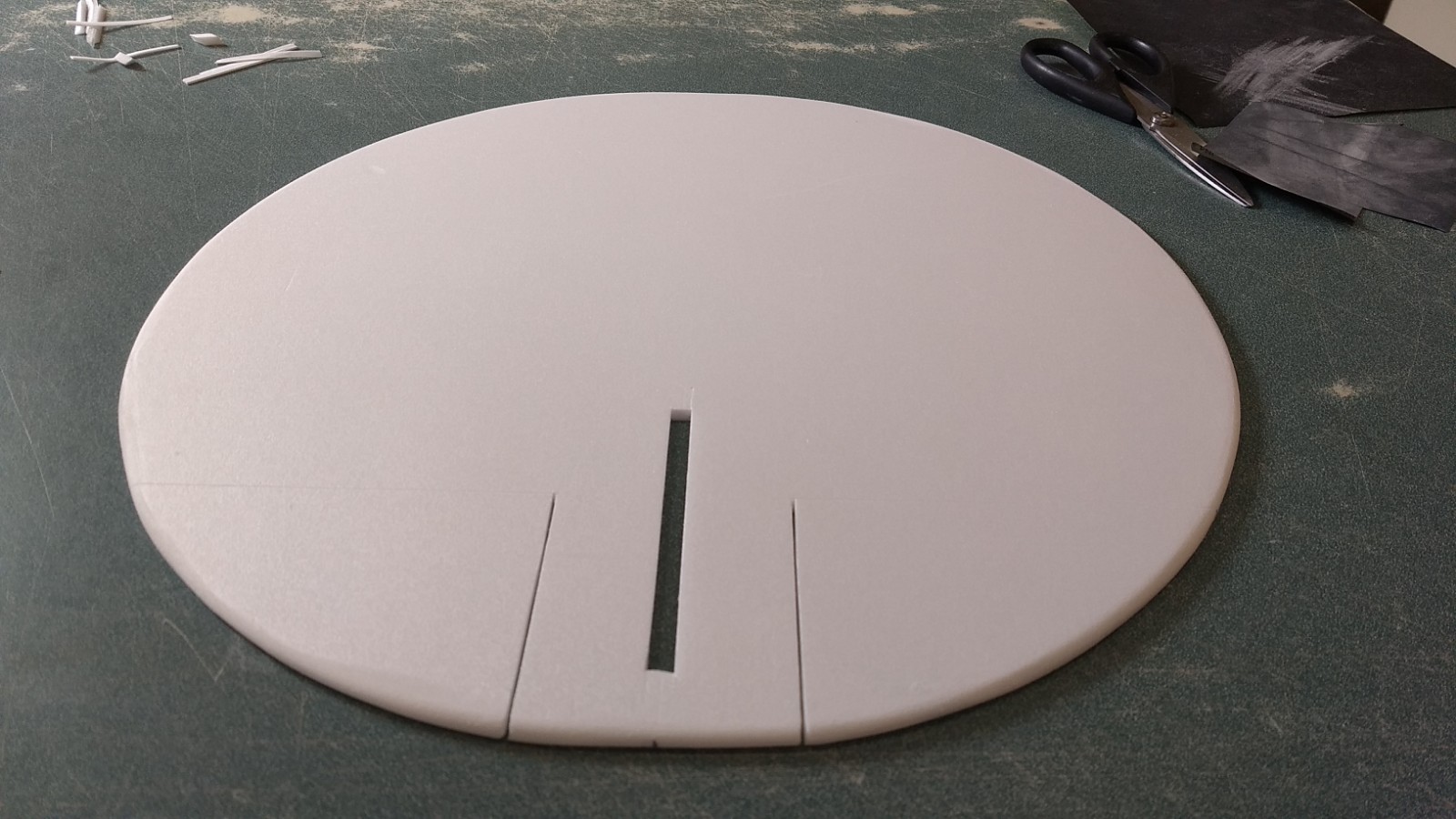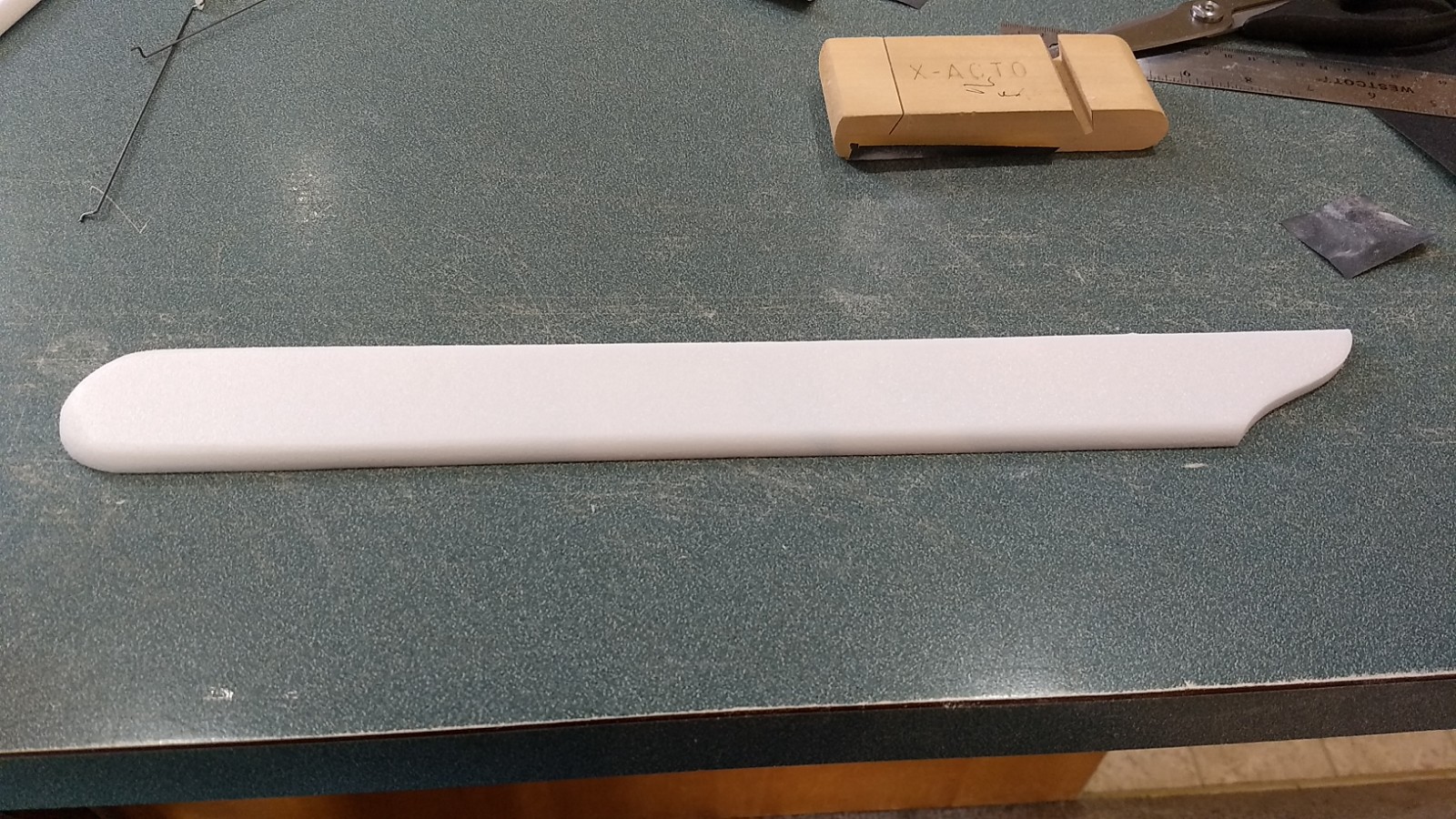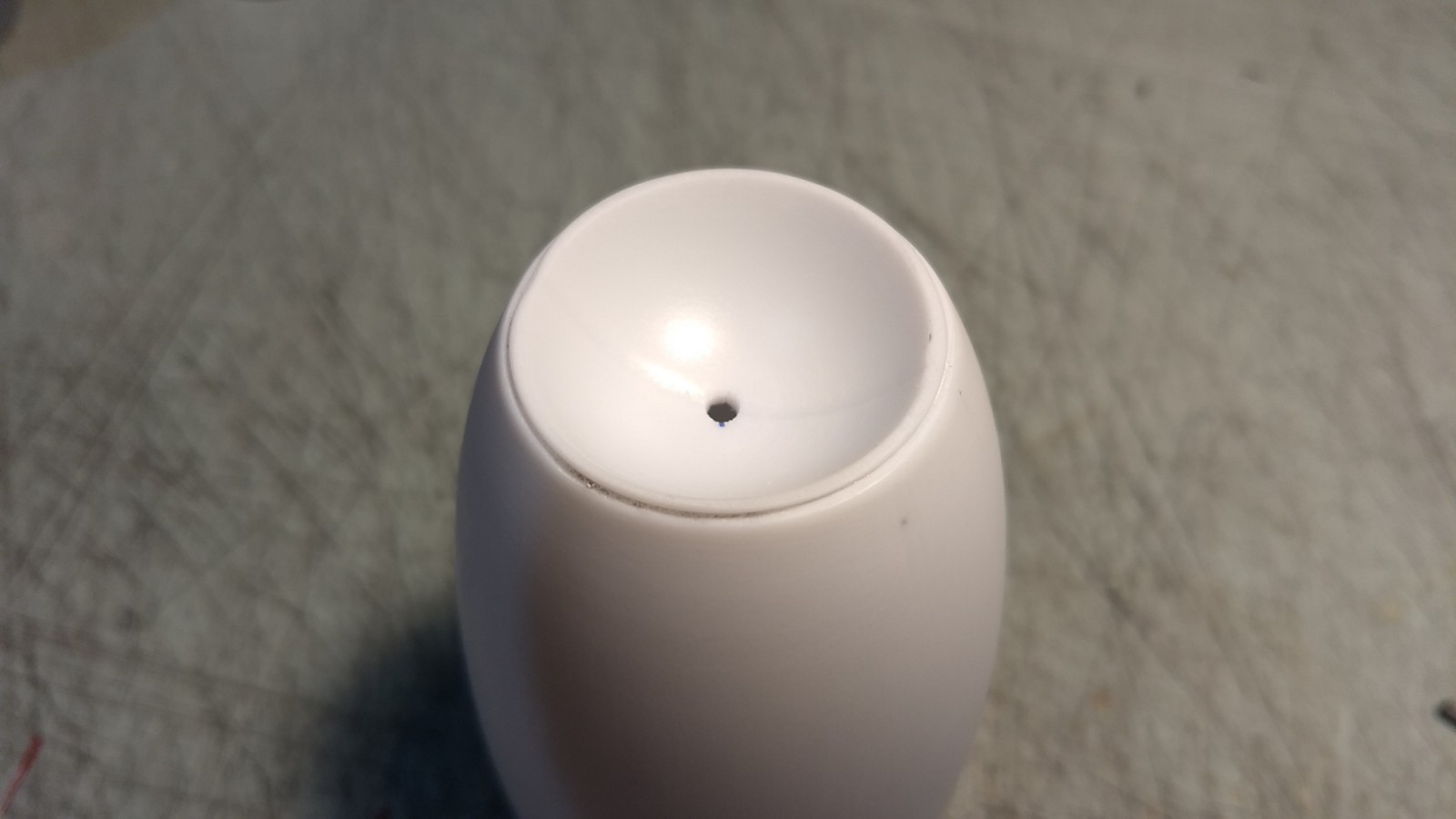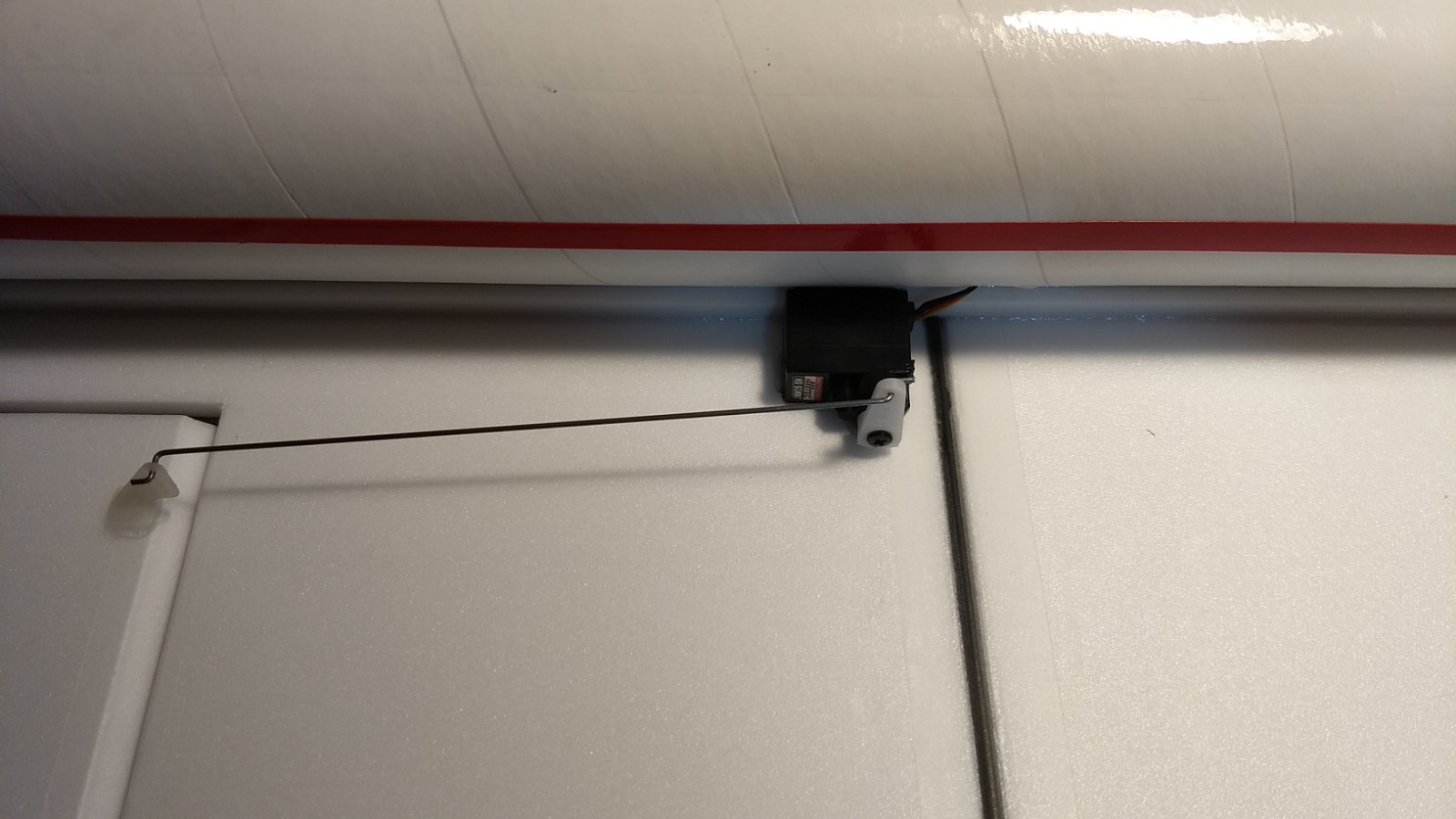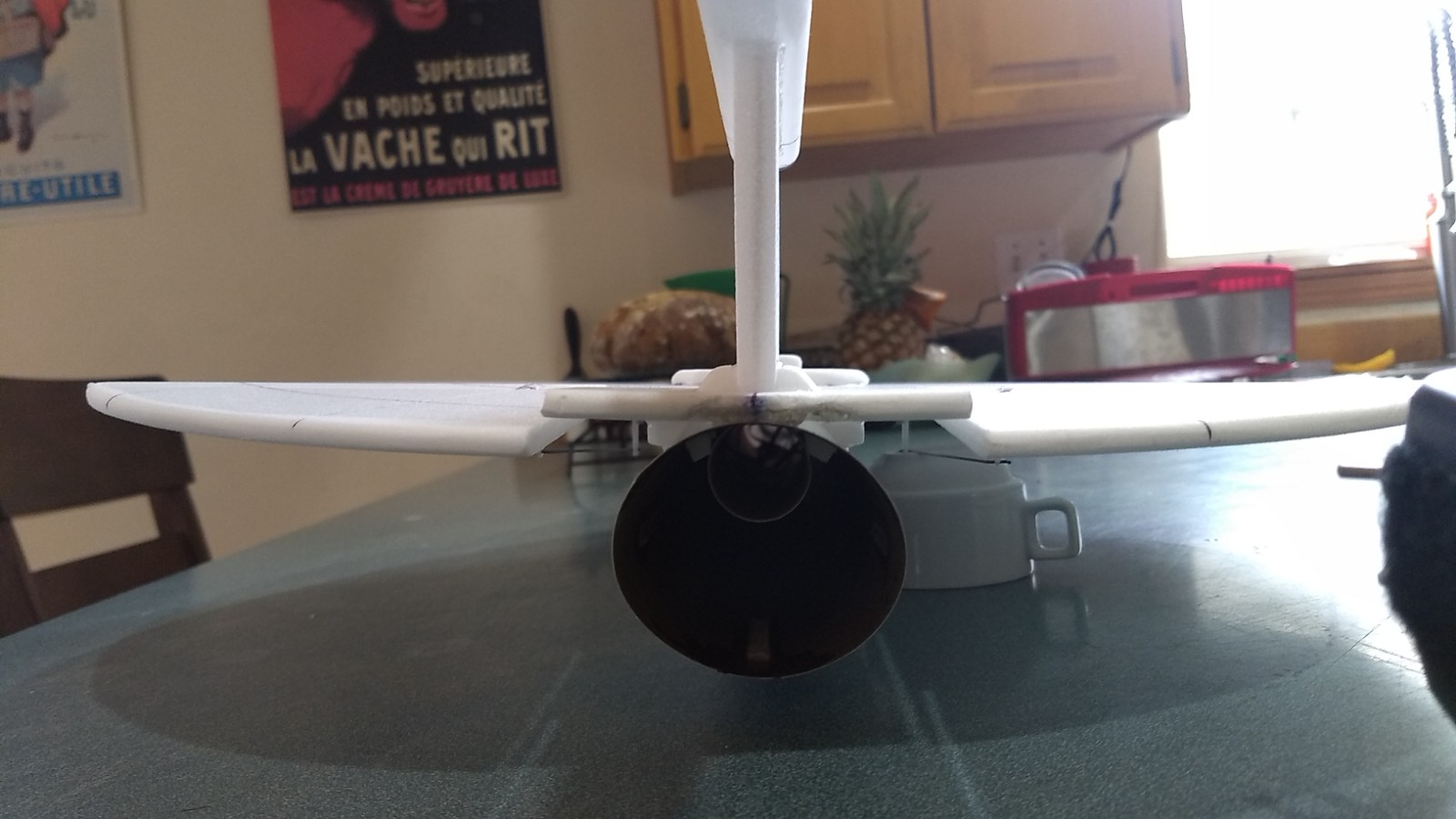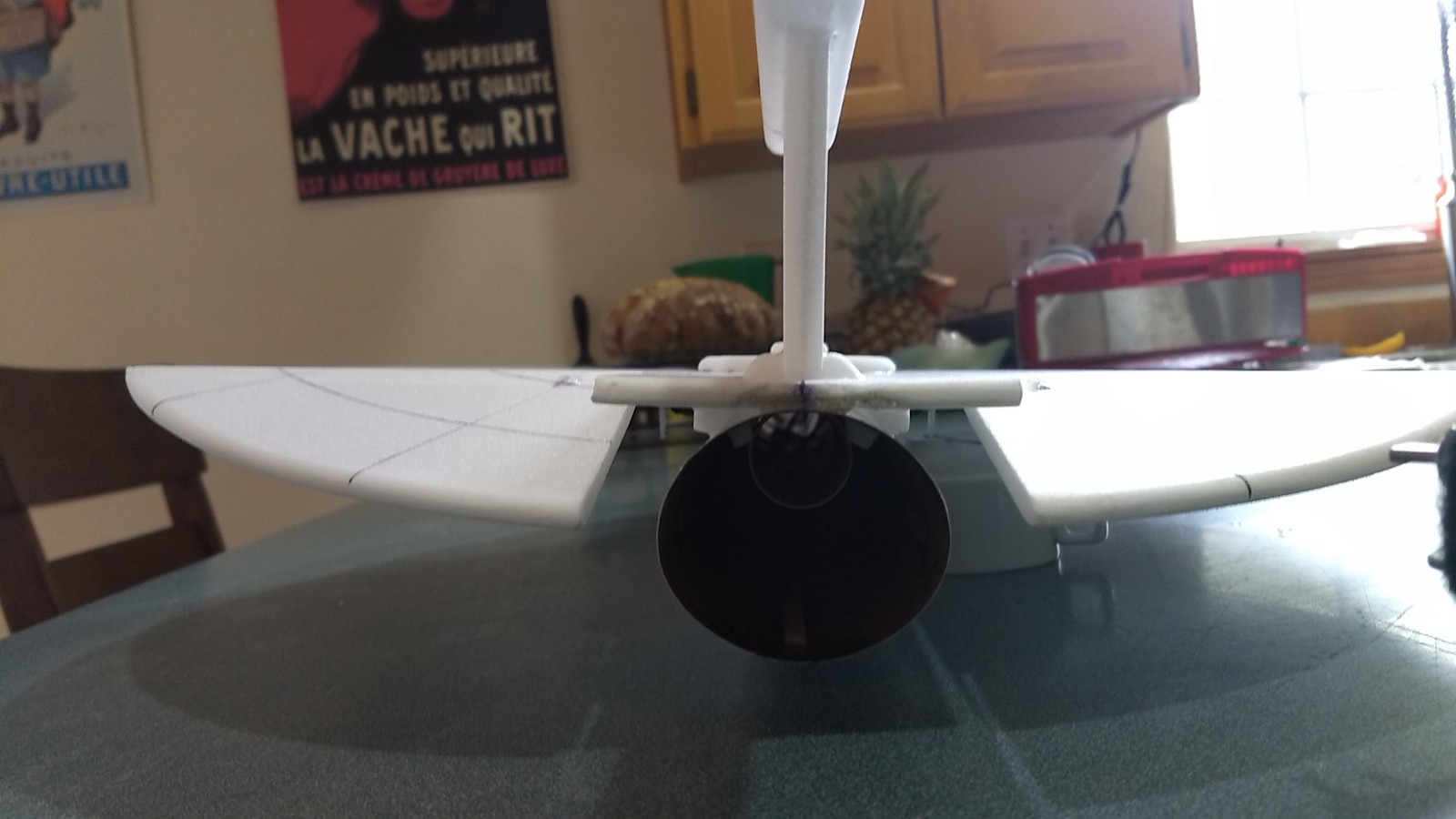
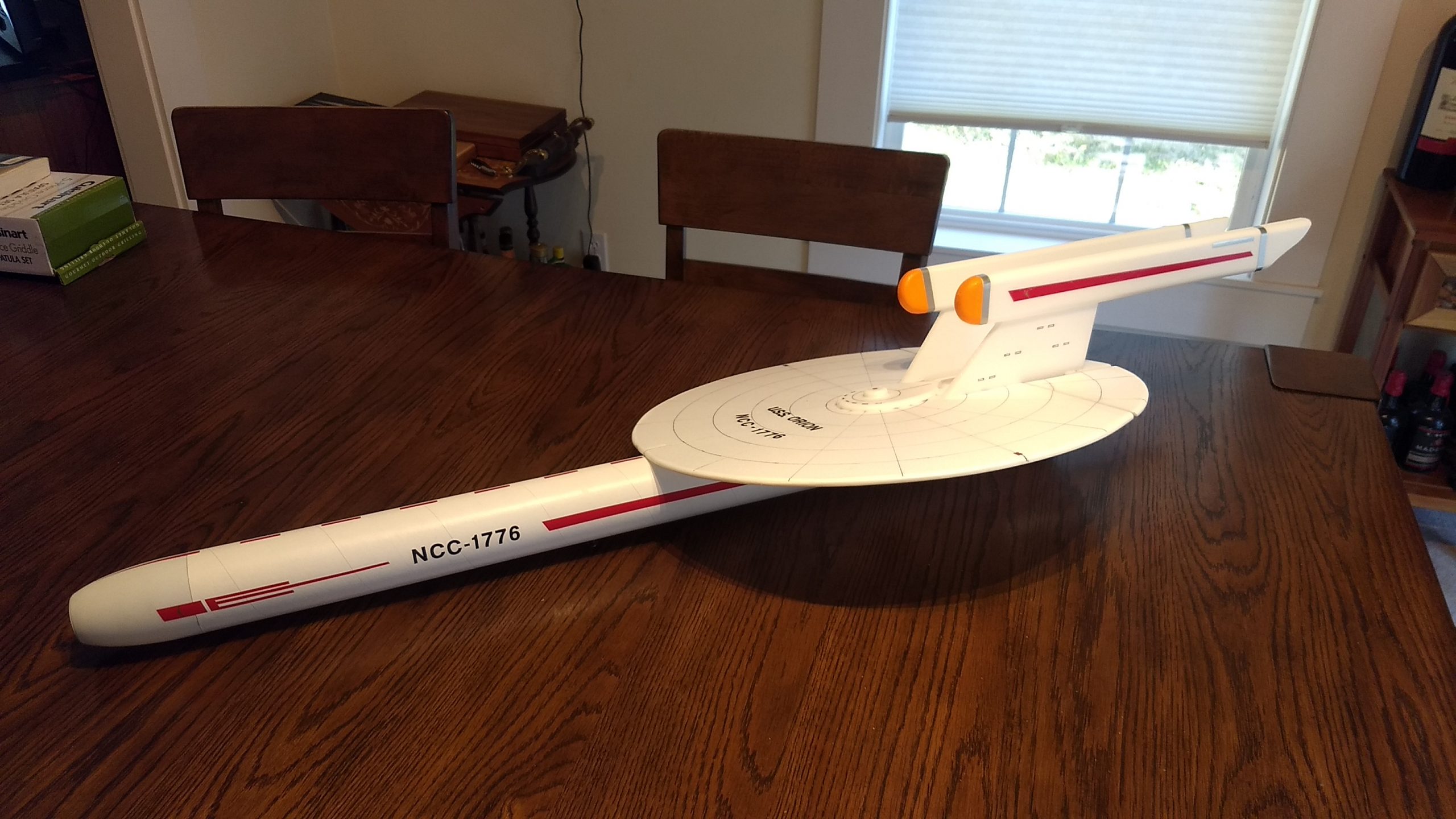
The Starship RC Rocket glider kit is designed using Star Trek stylings and shapes but is designed to glide. It has a disk shaped wing, a tail mounted warp engine, and a nose mounted deflector shield. It comes with a plastic nose cone, 2.6″ white tubing for the body, 6mm Depron wing and 9 and 6mm depron tail surface. The wing spar is installed, control surfaces are pre-hinged, and the body tube is pre-cut for the included rail buttons. Please refer to the General information for all kits tab above, then read these instructions completely before starting assembly. High quality cut vinyl decals will be available HERE
CG location for rocket flight: 16 3/8″ forward of the rear end of the wing. 47″ long, 19″ disk/wingspan, 2.6″ diameter, 11.25 oz rtf.(twin warp engine version adds one ounce to the flight weight)
Unpacking your kit:
The kits are packed to protect them in shipping, but the contents are fragile so unpack carefully. Carefully cut the tape holding the tubes in the box, then unwrap/lightly cut the plastic wrap to free the tubes, the spar may be packed in the tubes and the baggie with the little parts and nose cone will be in the tubes as well. Carefully cut the tape holding the cardboard wing protector in the box and carefully remove it, don’t pull hard or bend it. Then carefully cut the tape holding the cardboard top piece to the bottom. There may be some sticky tape holding the cardboard to the bottom cardboard piece, carefully peel it being sure not to bend anything. Once the top cardboard is free you can see the foam wing/tail parts, there are little fragile pieces in here, so unwrap carefully. It may be best to use an exacto to lightly cut the plastic wrap and carefully remove it without cutting into the foam. Make sure everything is free before you remove the pieces to avoid breaking anything. Kits contain one or two scrap pieces for repairs if you damage anything in construction or flight, just cut and patch in a spare piece of the foam if needed using foam safe CA+.
Welcome to the world of rocket boosted radio control gliders. This is not a model for a novice RC pilot, but anyone who is comfortable with RC flying of a medium speed model should be fine. Read through the instructions, look at the photos and be sure you understand the step before committing to cutting or glue.
Identify all pieces, the kit should contain:
1 wing
1 lower bridge(oval-ish)
1 upper bridge(circle)
1 Nose Cone with separated tip
1 1.5″ long carbon deflector shield post
2 18″ long wing reinforcing strips
2 6″ long tail reinforcing strips.
1 or 2 9mm vertical stabilizer cores
2 or 4 6mm warp engine doublers
2 control horns/Pushrods
2 Body Tubes
1 coupler
Motor mount
thrust ring
2 2.75″ long angle cut strips to reinforce the motor tube
Velcro(for battery and rx/bec attachment)
2 Rail buttons with t nuts/screws
Lead weight
Notes before starting:
Foam safe CA+(Bob smith super gold + is good) is the only glue recommended for construction. You will also need foam safe accellerator to set the glue.
Assembly:
- Unfold the wing and glue the taped joint with CA+
- To really give this kit the look it needs you will need to round the edges of several parts. You need to use a VERY light touch and 320 grit paper and a sanding block to do this, take your time and do little areas at a time, if you try to do large lengths at one time the block can catch and tear the foam. Round the following:
- Top of the wing edge
- Top of the circular upper bridge
- Top of the oval-ish lower bridge
- one side of each warp engine doubler, you need to make a left and righthand version!! Don’t sand the rear of the piece!
- Glue the left and right warp engine doublers onto the 9mm core, the core may have some warpage from the foam sheet, laminate each side on pressing it firmly onto a flat surface till cured to make sure it stays straight. When done, lightly dress the edges to make them match the core. If you have a two warp engine version repeat for the other side.
- At this time I found it is easier to do the panel lines on the disk portion before assembly. I used a drawing compass in the center of the wing and made a circle with a 2″ radius from the center, and one at every 1.5″ after that. I simply taped my sharpie fine line pen to one end of the compass. If your compass is not large enough for the outer circles, do like I did and tape chop sticks to both legs of the compass and then tape the pen to one of the legs. Take your time. I then marked a line accross the middle side to side and front to back, then used a protractor to mark 45 degree lines in between each one and then divided them again at 22.5 degrees. You should wind up with 5 circles and 16 lines on the disk. See photos for clarity.
- Install the two rail buttons into the pre-made holes in the rear body tube.
- Glue the two tubes together using the coupler so that the arrow marks are aligned.
- Glue the wing onto the top of the body tube even with the rear of the body tube, the slot goes to the rear of the model. I used a bit of tape to hold the wing aligned at the front and rear on the lines then flipped the model over and made sure the rail buttons were sticking straight up and held it in place till the glue set.
- Glue in a foam angle cut filler strip on each side of the body tube/wing joint to give more gluing surface. Don’t press this in too tightly or it will roll the tube to one side. Repeat on the other side, then apply a fillet of glue down both sides on both the wing and body tube joints and let set.
- Glue the thrust ring even with the front of the motor tube.
- With the model upside down, glue the motor tube onto the inside top rear of the body tube. There is a line marked to keep it straight, the rear of the motor tube should be recessed 1.75″ from the end of the body tube at the top. When set glue the short angle cut strips on each side and reinforce with CA to help provide a good glue joint.
- When complete, soak the inside ends of the body tube behind the motor mount and behind the rail button with foam safe ca to help stiffen the tube where it sits on the rail stop and to protect it from the motor exhaust.
- If your model has a single warp engine follow this step.
- Flip the model over and Glue the vertical fin into place and make sure the vertical fin is straight up and down. Apply the short reinforcing strips to both sides of the vertical stab at the base and reinforce with a glue fillet on each side.
- If your model has two warp engines follow these steps.
- Find the right warp engine pod, this one has a bevel cut at the bottom of the warp engine tab that goes through the wing, the bevel will be on the outside of the tab when you install it.
- Test fit then glue the warp engine to the disk, it will angle inward and make contact with the side of the body tube, apply glue to the tab at the body tube contact area to lock this in place, then fillet all joints.
- Repeat for the other side.
- Glue the lower bridge onto the disk wing on top approx in the middle. The piece is sort of oblong and the rear portion should be about 1/2″ forward of the vertical stab where it hits the wing. Use the circles drawn and the cross lines on the wing to help space it in the center.
- Glue the upper bridge onto the lower bridge using the cross lines on the wing to find the center.
- Note that there should be two holes on each control surface. Apply CA+ to each of the control horns and press them in place in the underside of each control surface into the pre-made holes. The control horn holes face forward and the pushrod should be closest to the body tube. Apply a drop of glue around the control horn prongs on the top of the control surface to lock them in place.
- Test fit the forward nose cone end onto the nose cone. Lightly sand till it seats nicely, but don’t oversand so it will fall through!! Hold in place and use CA dropped from the rear onto the joint from inside and hold till it sets.
- Using a 3mm drill or exacto, make a hole in the center of the disk till the carbon rod will fit and glue in place with it flush with the front of the cone and the rounded portion is pointing out.
the basic construction of the airframe is complete.
Radio Installation
Note: Your radio needs to be configured for Delta mixing, this means that the servo arms will move the same direction during elevator stick movement and opposite for aileron stick movement. Connect your servos to the receiver one in the aileron connection and one on the elevator connection and apply power. Use a servo arm at least 9/16” long and with holes small enough that there won’t be slop with the pushrod wire when installed. I use the hole furthest out on the servo arm, to maximize movement. On some servos there are a long two-ended servo arm, you can trim off one end and use that arm to get sufficient length. Zero out any trim settings on the transmitter.
- Connect each servo to a pushrod. If the pushrod is too tight, you can use twist an X-Acto knife in the servo arm hole to make it larger, but be careful and do not make it too large. The servo should be next to the body tube on the bottom of the wing, with the servo electrical wire pointing forward and the servo arm pointing toward the wing tip. Hold each servo in place so that the control surfaces are centered. With the model right side up look at it from the rear. Moving the transmitter stick back(up elevator) should move both elevons up. Moving the transmitter stick to the right should move the right elevon up and the left elevon down. If you can’t get the servo reversing to give you the right polarity try swapping aileron/elevator inputs to the receiver or turning the servos over and swapping the servo arms to the other side of the output shaft. If that is correct, continue.
- The servos may be attached to the model using double back servo mounting tape(not included) or by directly gluing the servo to the wing with foam safe CA+. Double back servo tape can loosen over time and with exposure to heat, I prefer to glue the servo in place. With the radio still on, put a moderate amount of glue on the servo, being careful not to get any near the output shaft, and set it in place on the model next to the body tube keeping the control surface centered. Do the same to the other side. Make sure the glue is set before continuing. Note** The servo wire should point toward the front of the model. Apply a fillet of glue around the servo/wing to help secure it and let it cure being careful not to get any glue near the output shaft of the servo.
- Attach a 24″ servo extension to each servo. You need to be able to route the wire to the front of the tube to attach it to the receiver.
- Make a 1/8″ wide by 1/2″ long slot in the body tube on each side of the body tube near the servo and pass the wires through to the inside and toward the front. On my model I just made a U shaped cut, folded the cardboard forward, inserted the wire then folded the cardboard back over the slot/wire. I then glued the cardboard tab in place. See photo for more clarity. I taped the servo wires down to the wing using the blenderm tape.
- Re-Attach the servo wires to the receiver and make sure they are going the right direction.
- Make sure the control surfaces are centered, use trims if neejded. Now measure the control surface movement. Full elevator movement should be 1″ in each direction, aileron movement should be 3/4″ in either direction. Note these look like a lot of movement but the surface is curved so the deflection at the inboard tip is a lot but not so much outboard. All measurements at the inboard surface tip.
- If you have a flap/elevator mix you can program elevator trim for boost and glide. If you can’t set the elevator trim to a switch on your radio you’ll have to manually put in boost and glide trim using the trim tabs which is hard to do while flying the model. My model needed 3/8″ down trim for boost and 1/2″ to 5/8″ of uptrim for glide. All measurements at the inboard tip of the control surface. The downtrip is needed on boost due to the large draggy vertical tail/warp engine.
- Use the included Velcro to attach the receiver inside the the nose cone shoulder at the top.
- I attached the battery inside the nose cone on the bottom of the shoulder with velcro.
- Install the receiver and battery
- Insert your heaviest loaded rocket motor into the motor mount
- Support the model rightside up at the balance point indicated for boost. Glue lead weight in the nose as needed to balance it. Do not try to fly the model too nose or tail heavy. Remember, a nose heavy model flies poorly, a tail heavy model flies once.
- I used a foam safe acrylic tamiya orange flourescent paint for the front of the warp engine. I used a gold sharpie for the deflector dish. The rest of the windows and panel lines were done using a sharpie pen and clear drawing triangles.
- If using the stickershock23 vinyl after applying use a hot hair dryer to soften the decal and press it into the surface, especially important on the foam, this will help it set and coform better. The decals are identical for the one or two warp engine versions, the warp engine decals go on the outside of each engine on the twin version or on both sides of the single pod version.
- Flying: See the General Instruction link at the top for flying instructions. Be ready on the first few flights to keep the model straight till you have the trims set perfectly for boost and glide.
The photos below are for reference but please read through and follow the steps in order as the text is written.
- Kit parts.
- Glue taped center wing joint
- Glue the wing at the taped joint and lay flat till the glue sets. Edges of the wing shown rounded after sanding.
- Rounded upper and lower bridge edges.
- rounded warp engine doubler
- panel lines and circles drawn onto top of wing/disk.
- warp engine doubler glued onto 9mm core.
- Join the two body tubes so that the arrow alignment marks align.
- Install rail buttons.
- Glue wing onto tube even with the rear of the model, flip over to set.
- add the reinforcing strips on both sides.
- Glue the motor tube 1.75″ in from the end of the top inside of the body tube and glue the two reinforcing strips on both sides, then soak the end of the tube at the top and bottom with foam safe CA to reinforce it.
- Glue in the vertical stab.
- glue the reinforcing strips on both sides of the vertical stab.
- On the twin warp engine version glue the two warp engines in place.
- Glue the warp engine tab to the body tube on both sides on the twin warp engine version.
- glue on the lower and upper bridge.
- Glue in the nose cone tip
- make a hole in the center.
- glue in the deflector disk post.
- glue in the pushrods and control horns.
- add glue onto the top of the prongs of the control horn to lock them in place.
- Completed airframe.
- Servo installed
- Servo wire routed into body tube
- Mount the battery and receiver in the nose cone using velcro
- Nose detail
- Warp pod pylon detail
- Deflector shield detail
- Disk detail
- Completed model
- down trim for boost
- up trim for glide.
- down elevator
- up elevator
- left aileron
- right aileron
- Example of stickershock markings


